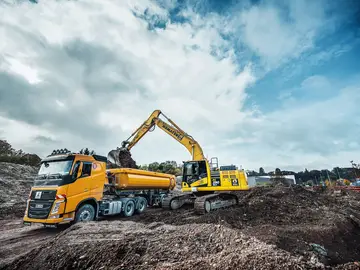Focusing on the sustainable use of resources: Bauer Resources carries out soil remediation on former tannery site
Backnang, Germany – For more than 150 years, the site at “Obere Walke” in Backnang, northeast of Stuttgart, was one of the defining characteristics of the former tannery city. These days, however, there is nothing left that would serve as a reminder of the days of the former leather factory. All industrial buildings were completely demolished in 2011, and the wasteland now resembles a lunar landscape. After the owner and the municipality reached an agreement on the reorganization of the urban development, preparatory measures for the construction of a care home on a section of the 50,000 m2 site have begun in August. DIBAG Industriebau AG commissioned the Bauer Umwelt Division of BAUER Resources GmbH to carry out soil remediation works for the construction of an excavation pit. The aim is to eliminate any residues remaining in the soil from the former use of the site as a tannery.
But before pit excavation could actually commence and the 30 t excavator be put to use, an area for the interim storage of the soil had to be created. The soil needs to be separated, i.e. the accompanying expert decides directly on site which part of the excavated soil needs to be disposed of due to its level of contamination, and which excavation material can safely be put to further use on the building site. “This approach allows us to dramatically reduce soil wastage and conserve valuable resources,” explains Operations Manager Jan Uhlig from Bauer Umwelt Division and adds: “The sustainable use of resources is part of the remediation strategy and is very important to both us as well as the client.”
Once preparation of the area had been completed by Foreman Erwin Resch and his team, a start was made on the ground in September 2021. Around 26,000 m3 of contaminated soil is excavated to a depth of 4 m below the ground surface and separated accordingly. The biggest challenge this year is going to be the weather, stresses Jan Uhlig: “When large amounts of water react with highly cohesive soil, this leads to a certain amount of extra effort and calls for increased caution. You need experience and flexibility for this type of situation. We are a well-coordinated team. Everyone knows what they have to do and what is important at any given moment. That’s how we can ensure good construction progress at all times and complete the excavation works on schedule in November.” Covering the excavated material headed for disposal protects it from wind erosion and rain water, which in turn prevents the discharge of contaminants.
Removal of unusable material will take place until the middle of November, which also marks the completion of the works by Bauer. The soil is transported to the nearest disposal facilities within a radius of 25 km to further minimize environmental impact and CO2 emissions as much as possible.gerade wichtig ist. Dadurch können wir stets einen guten Baufortschritt sicherstellen und die Aushubarbeiten nach Plan im November abschließen.“ Eine Abdeckung auf den Haufwerken sorgt dafür, dass das zu entsorgende Aushubmaterial gegen Winderosion und Niederschlagswasser geschützt wird und somit auch der Austrag von Schadstoffen verhindert wird.
Bis Mitte November erfolgt nun der Abtransport des nicht verwendbaren Materials und damit der Abschluss der Arbeiten seitens Bauer. Um auch hier die Umweltauswirkungen und den CO2-Ausstoß so gering wie möglich zu halten, wird der Boden zu den nächstgelegenen Entsorgungsstellen im Umkreis von 25 km transportiert.
Downloads
Your Contact
Specialized press Resources, Redevelopment, Environment
